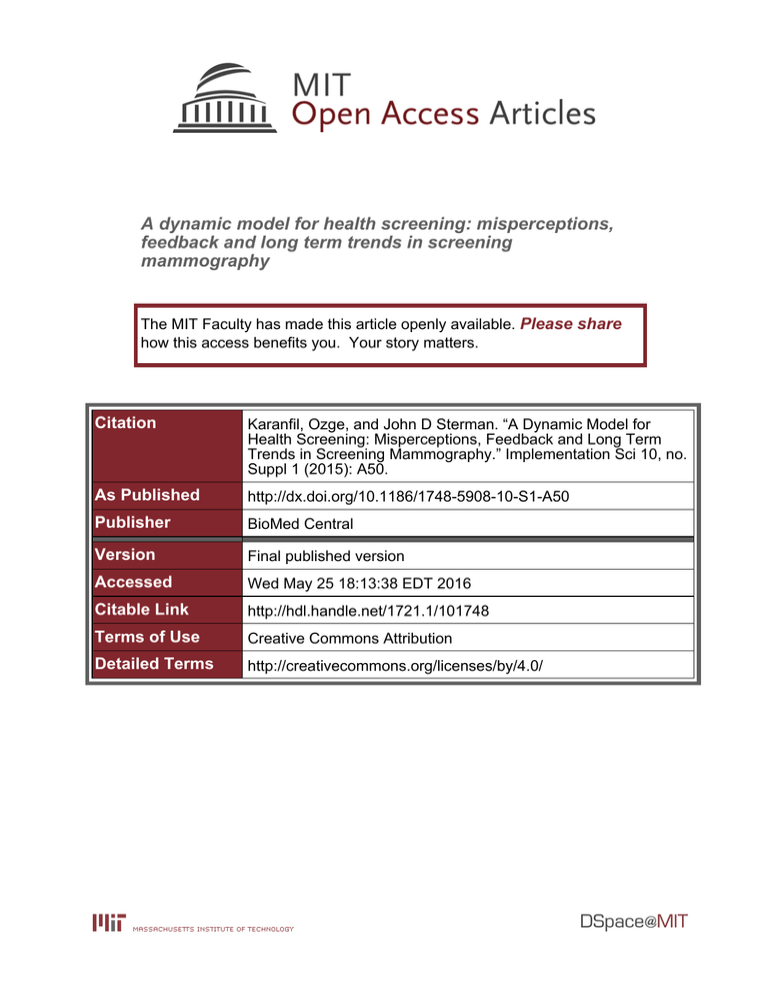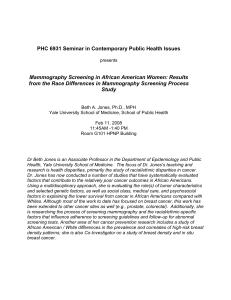A dynamic model for health screening: misperceptions, mammography
advertisement

A dynamic model for health screening: misperceptions, feedback and long term trends in screening mammography The MIT Faculty has made this article openly available. Please share how this access benefits you. Your story matters. Citation Karanfil, Ozge, and John D Sterman. “A Dynamic Model for Health Screening: Misperceptions, Feedback and Long Term Trends in Screening Mammography.” Implementation Sci 10, no. Suppl 1 (2015): A50. As Published http://dx.doi.org/10.1186/1748-5908-10-S1-A50 Publisher BioMed Central Version Final published version Accessed Wed May 25 18:13:38 EDT 2016 Citable Link http://hdl.handle.net/1721.1/101748 Terms of Use Creative Commons Attribution Detailed Terms http://creativecommons.org/licenses/by/4.0/ Karanfil and Sterman Implementation Science 2015, 10(Suppl 1):A50 http://www.implementationscience.com/content/10/S1/A50 Implementation Science MEETING ABSTRACT Open Access A dynamic model for health screening: misperceptions, feedback and long term trends in screening mammography Ozge Karanfil*, John D Sterman From 7th Annual Conference on the Science of Dissemination and Implementation in Health North Bethesda, MD, USA. 8-9 December 2014 Implications of widespread mammography screening remain controversial, and major health organizations in the US adopt different guidelines reflecting significant variations in actual practice. Literature suggests that implementation of routine screening over the past 30 years has incurred less benefit and more harms than is formerly believed. The classical approach to setting guidelines is based on the statistical paradigm of Type-I and Type-II errors, seeking to find an evidence-based balance between sensitivity (and thus the risk of false positives) and specificity (and the risk of false negatives), given the costs and benefits of different outcomes. Clearly, however, a wide range of other considerations play important roles in determining both the formal guidelines and how these are implemented, interpreted and acted upon by providers, payers, patient advocacy groups, and other stakeholders and actors. Science and scientific evidence, including the processes that generate evidence, are embedded in and not independent of a social, economic and political system. In this study we develop the first explicit and integrated, broad boundary feedback theory around the dynamics of health screening. The theory we develop includes a decision-theoretic core around the costs and benefits of screening including the fundamental tradeoff between sensitivity and specificity. It also includes some of the sociopolitical feedbacks that condition formal guidelines, public perception, and the actual practice. To provide context, we use the mammography case as the motivating example, but our model is generic enough to be applicable to other contexts of population health * Correspondence: karanfil@mit.edu MIT Sloan School of Management, System Dynamics Research Group, Cambridge, MA 02142, USA screening, such as the prostate-specific antigen (PSA) screening. Our model is tightly grounded in empirical evidence base, and we use a mix of qualitative/quantitative methods and mainly system dynamics to explain the dynamic nature of the medical screening problem within the US context. This study is part of my PhD dissertation and funded by MIT. Published: 20 August 2015 doi:10.1186/1748-5908-10-S1-A50 Cite this article as: Karanfil and Sterman: A dynamic model for health screening: misperceptions, feedback and long term trends in screening mammography. Implementation Science 2015 10(Suppl 1):A50. Submit your next manuscript to BioMed Central and take full advantage of: • Convenient online submission • Thorough peer review • No space constraints or color figure charges • Immediate publication on acceptance • Inclusion in PubMed, CAS, Scopus and Google Scholar • Research which is freely available for redistribution Submit your manuscript at www.biomedcentral.com/submit © 2015 Karanfil and Sterman. This is an Open Access article distributed under the terms of the Creative Commons Attribution License (http://creativecommons.org/licenses/by/4.0), which permits unrestricted use, distribution, and reproduction in any medium, provided the original work is properly cited. The Creative Commons Public Domain Dedication waiver (http://creativecommons.org/ publicdomain/zero/1.0/) applies to the data made available in this article, unless otherwise stated.


